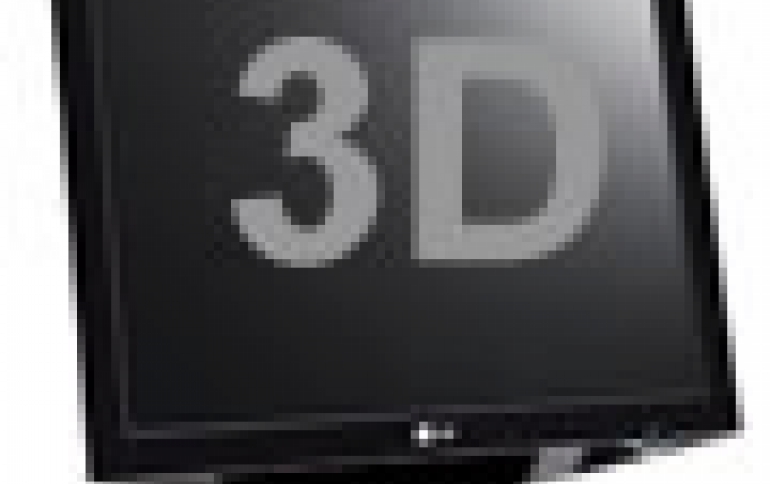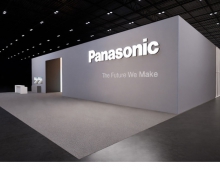
Battle Over 3D TVs Heats Up at CEATEC
Sony and Panasonic will be showcasing their latest advancements in the next-generation TVs using three-dimensional technology at CEATEC, Japan?s biggest information technology and electronics fair.
Both Japanese companies will showacese products that can bring the 3D technology from cinemas into homes.
At the event, Sony will display liquid crystal display TVs capable of showing 3D images that it plans to launch next year. A total of eight 3D compatible "BRAVIA"LCD TVs wil be on display on stage showcasing 3D movie, game and sports content. For the demonstration, Sony will use a 52" Full HD BRAVIA LCD TV, the same the company used in the IFA 09 show in Germany. Visitors will have the chance to enjoy 3D content using active shutter glasses.

Sony will also demonstrate a single lens 3D camera capable of filming 3D content at a frame rate of 240 frame/sec as well as the "SRX-R220", a Digital cinema projector for professional use, optimized for 3D projection. The system incorporates US company RealD's 3D digital cinema system to deliver both high resolution 4K 2D projection, and also 3D images in a single projection unit.
Panasonic will showcase a 50-inch high-definition 3D plasma TV to be delivered sometime in 2010.
This 50-inch PDP uses Panasonic's newly-developed high-speed 3D drive technology that enables rapid illumination of pixels while maintaining brightness. The panel also incorporates a crosstalk reduction technology allowing for minimizing double-image (ghosting) that occurs when left- and right-eye images are alternately displayed. PDPs have excellent video response with full moving picture resolution. The new panel offers even improved performance, achieving clear, high-quality and high-resolution images in 3D, Panasonic claims. The high-precision active shutter glasses incorporate Panasonic's technology that precisely controls the active shutters with the left- and right-eye images shown on the PDP.

Panasonic has been working to develop its original Full HD 3D technology to create synergy between PDPs, which excel in moving picture resolution and color reproduction, and Blu-ray Disc players, which are able to faithfully reproduce high quality Hollywood 3D movies. In Panasonic's Full HD 3D technology, full HD x 2 frame sequential method displays time sequential images, alternately reproducing discrete 1920 x 1080 pixel images for the left and right eyes on the screen frame by frame.
Panasonic said that it would continue to work on developing 3D products, targeting to launch the products in Japan, Europe, and the U.S. in 2010. However, this data could change since the 3D Expanded Standard is currently under review by the Blu-ray Disc Association (BDA).
Meanwhile, Toshiba will put on exhibition its first Regza LCD TV powered by the Cell processor that will allow viewers to record up to eight channels. Combined with the 55-inch TV, the company also plans to unveil a 3D version of the Cell Regza platform in future versions.
Sony will also showcase its High frame rate "MotionFlow" technology, demonstrating the smooth playback of fast moving images realized by increasing the number of frames from 60Hz/sec to 240Hz/sec.
A reference design of the company's 2.5inch flexible OLED screen will be also available at Sony's booth. With 0.2mm thinness that incorporates a flexible organic thin film transistor to drive its display. Sony flexible OLED prototype is actually a television so thin it can actually bend. In the future, the technology might allow people to own a screen that could fold as easily as a magazine that displayed content in color and dynamically updated itself daily. Called "Flex OLED", Sony's 2.5-inch protoype displays in the resolution 160x120. Possible aplications of this flexible OLED display include use in electronic books (electronic paper), or even as part of a bracelet Walkman, that will display artist and song information wrapped around your hand. Other concepts based on OLED displays include a dual OLED screen Sony Vaio notebook, featuring a 0.2-millimeter thin screen on both the screen and keyboard area.
CEATEC JAPAN 2009 is held from October 6 to 10 at Makuhari Messe in Chiba City, east of Tokyo.
At the event, Sony will display liquid crystal display TVs capable of showing 3D images that it plans to launch next year. A total of eight 3D compatible "BRAVIA"LCD TVs wil be on display on stage showcasing 3D movie, game and sports content. For the demonstration, Sony will use a 52" Full HD BRAVIA LCD TV, the same the company used in the IFA 09 show in Germany. Visitors will have the chance to enjoy 3D content using active shutter glasses.

Sony will also demonstrate a single lens 3D camera capable of filming 3D content at a frame rate of 240 frame/sec as well as the "SRX-R220", a Digital cinema projector for professional use, optimized for 3D projection. The system incorporates US company RealD's 3D digital cinema system to deliver both high resolution 4K 2D projection, and also 3D images in a single projection unit.
Panasonic will showcase a 50-inch high-definition 3D plasma TV to be delivered sometime in 2010.
This 50-inch PDP uses Panasonic's newly-developed high-speed 3D drive technology that enables rapid illumination of pixels while maintaining brightness. The panel also incorporates a crosstalk reduction technology allowing for minimizing double-image (ghosting) that occurs when left- and right-eye images are alternately displayed. PDPs have excellent video response with full moving picture resolution. The new panel offers even improved performance, achieving clear, high-quality and high-resolution images in 3D, Panasonic claims. The high-precision active shutter glasses incorporate Panasonic's technology that precisely controls the active shutters with the left- and right-eye images shown on the PDP.

Panasonic has been working to develop its original Full HD 3D technology to create synergy between PDPs, which excel in moving picture resolution and color reproduction, and Blu-ray Disc players, which are able to faithfully reproduce high quality Hollywood 3D movies. In Panasonic's Full HD 3D technology, full HD x 2 frame sequential method displays time sequential images, alternately reproducing discrete 1920 x 1080 pixel images for the left and right eyes on the screen frame by frame.
Panasonic said that it would continue to work on developing 3D products, targeting to launch the products in Japan, Europe, and the U.S. in 2010. However, this data could change since the 3D Expanded Standard is currently under review by the Blu-ray Disc Association (BDA).
Meanwhile, Toshiba will put on exhibition its first Regza LCD TV powered by the Cell processor that will allow viewers to record up to eight channels. Combined with the 55-inch TV, the company also plans to unveil a 3D version of the Cell Regza platform in future versions.
Sony will also showcase its High frame rate "MotionFlow" technology, demonstrating the smooth playback of fast moving images realized by increasing the number of frames from 60Hz/sec to 240Hz/sec.
A reference design of the company's 2.5inch flexible OLED screen will be also available at Sony's booth. With 0.2mm thinness that incorporates a flexible organic thin film transistor to drive its display. Sony flexible OLED prototype is actually a television so thin it can actually bend. In the future, the technology might allow people to own a screen that could fold as easily as a magazine that displayed content in color and dynamically updated itself daily. Called "Flex OLED", Sony's 2.5-inch protoype displays in the resolution 160x120. Possible aplications of this flexible OLED display include use in electronic books (electronic paper), or even as part of a bracelet Walkman, that will display artist and song information wrapped around your hand. Other concepts based on OLED displays include a dual OLED screen Sony Vaio notebook, featuring a 0.2-millimeter thin screen on both the screen and keyboard area.
CEATEC JAPAN 2009 is held from October 6 to 10 at Makuhari Messe in Chiba City, east of Tokyo.





















